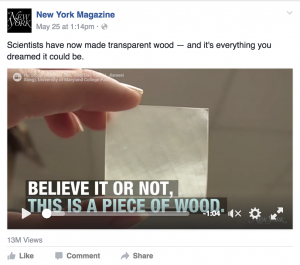OK, this will be my last post of this nature (for the moment).
You might have seen – 13 million other people did – a video about “transparent wood” out there on the interwebs:
Don’t know about you, but while I have had plenty of those show-up-to-school-in-my-underwear dreams, I have never dreamed about transparent wood.
The fact is, it is neither “transparent” nor “wood”. It might, however, be a very interesting development in materials – so why the completely bogus marketing effort?
Take one piece of wood, remove the lignin (evidently from a half-day boil), add epoxy, and what do you have? My guess is that you have a reinforced piece of plastic that exhibits slightly better strength than the resin alone, and about half the clarity.
That ain’t Transparent Wood by a long stretch. Is it, however, something worth looking at?
Interestingly enough, lignin has been experimented with as a plastic replacement, among many other things. On the other hand, natural fibers (fibres for those across the Pond) have also been extensively researched for their use as reinforcing elements. Everything from carrot fibers to linen have been incorporated into numerous products. The product in question is – sort of – burning the candle from both ends.
Could the lignin be used for other things? Make a more efficient extraction process, and – maybe.
Could less inefficient materials be added to epoxy to add strength and allow for more transparency than this “transparent” alternative? If a process can be created to get them into the resin in a cost-effective way – maybe. I’m curious to see if the auto industry’s investigation of injection-molded carbon can lead to better, more natural options.
In the meantime – dream of sheep, not transparent wood . . .

